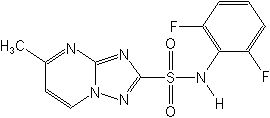-
Common NameFlumetsulam
-
中文通用名唑嘧磺草胺
-
IUPAC2′,6′-difluoro-5-methyl[1,2,4]triazolo[1,5-a]pyrimidine-2-sulfonanilide
-
CASN-(2,6-difluorophenyl)-5-methyl[1,2,4]triazolo[1,5-a]pyrimidine-2-sulfonamide
-
CAS No.98967-40-9
-
Molecular FormulaC12H9F2N5O2S
-
Molecular Structure
-
Category
-
ActivityHerbicide
Flumetsulam is active following applications to soil and to foliage. It can be applied prior to planting and pre-emergence in soybeans and pre-emergence to early post-emergence (from 2-4 true leaves in weeds) in maize. Flumetsulam is safe to maize, soybeans and small-grain cereals, but phytotoxic to oilseed rape, cotton and sugar beet. -
CropUseCropUses:
Small-grain cereals, maize, soybeans, peas, clover, medic and turf
Maize
79 g ai/ha
-
PremixThifensulfuron-methyl+bentazone+flumetsulam
Nicosulfuron+Atrazine+Flumetsulam
Florasulam+flumetsulam
Atrazine+Flumetsulam
Acetochlor+Atrazine+FlumetsulamWater-dispersible granule (WG)
Premix Parters: prothioconazole; prothioconazole trifloxystrobin;
-
Physical PropertiesMolecular weight:325.3; Physical form:Off-white, odourless solid. Density:1.77 (21 °C); Melting point:251-253 °C; Flash point:>93 °C; Vapour pressure:3.7 ×10-7 mPa (25 °C); Partition coefficient(n-octanol and water):logP = -0.68 (25 °C, unstated pH); pKa:4.6; Solubility:In water 49 mg/l ( pH 2.5); solubility increases with pH. Very slightly soluble in acetone and methanol. Insoluble in hexane and xylene.; Stability:Aqueous photolysis DT50 6-12 mo. Soil photolysis DT50 3 mo.
-
ToxicologyOral:Acute oral LD50 for rats >5000 mg/ kg. Percutaneous:Acute percutaneous LD50 for rabbits >2000 mg/kg. Slightly irritating to eyes (rabbits). Non-sensitising to skin (guinea pigs). Inhalation: LC50 (4 h) >1.2 mg/l. Phytotoxicity:Crops damaged by soil application of flumetsulam include sugar beet, cotton, oilseed rape, grain sorghum, tomatoes, and sunflowers. ADI:0.17 mg/ kg.
-
Environmental Profile
Ecotoxicology:
Bees: LC50 >100 μg/bee. NOEL 36 μg/bee. Birds:Acute oral LD50 for bobwhite quail >2250 mg/l. Dietary LC50 (8 d) for bobwhite quail and mallard ducks >5620 mg/l.Daphnia:Non-toxic.Fish: LC50 (96 h) for silverside minnow >379 mg/l. Non-toxic to fathead minnow and bluegill sunfish.Other aquatic spp.: LC50 for shrimp >349.
Environmental fate:
Animals:Rapidly cleared via urine and faeces with no metabolites. 5-Hydroxy metabolite found in the hen.Soil:Availability of flumetsulam in soil is principally dependent upon soil pH and organic matter. Herbicidal activity increases as pH increases and organic matter decreases. DT50 in soil (25 °C, Plant: DT50 in maize 2 h, soya beans 18 h, Chenopodium 131 h. Metabolites depend on the species; 5-hydroxy or 5-methoxy derivatives are common. -
Transport InformationHazard Class:III(Slightly hazardous)
Porduct NewsMore
Canada oks Dow AgroSciences’ herbicide flumetsulam
Related CompaniesMore
Country: China
MCPA Cyproconazole Imazamox Flumetsulam Haloxyfop-P-methyl Penoxsulam Florasulam Prothioconazole Clothianidin
Country: China
Glufosinate-ammonium 2,4-D MCPA Dicamba Propanil Clethodim Glyphosate Captan Flumioxazin Sulfentrazone
Jiangsu Agrochem Laboratory Co., Ltd.
Country: China
Florasulam Cloransulam-methyl Mesosulfuron-methyl Triflusulfuron-methyl Iodosulfuron-methyl Imazamox Halosulfuron Thidiazuron Flucarbazone-sodium Diclosulam
Jiangsu Repont Agrochemical Co., Ltd.
Country: China
Chlorimuron-ethyl Bensulfuron-methyl Thifensulfuron-methyl Ethxosulfuron Flucarbazone Carfentrazone Florasulam Metribuzin Flumetsulam Flazasulfuron.
Country: China
Bentazone Bispyribac-sodium Nicosulfuron Oxadiazon Quizalofop-p-ethyl Cyhalofop-butyl Fluroxypyr-meptyl Penoxsulam Metamifop

 0
0 Subscribe
Subscribe
